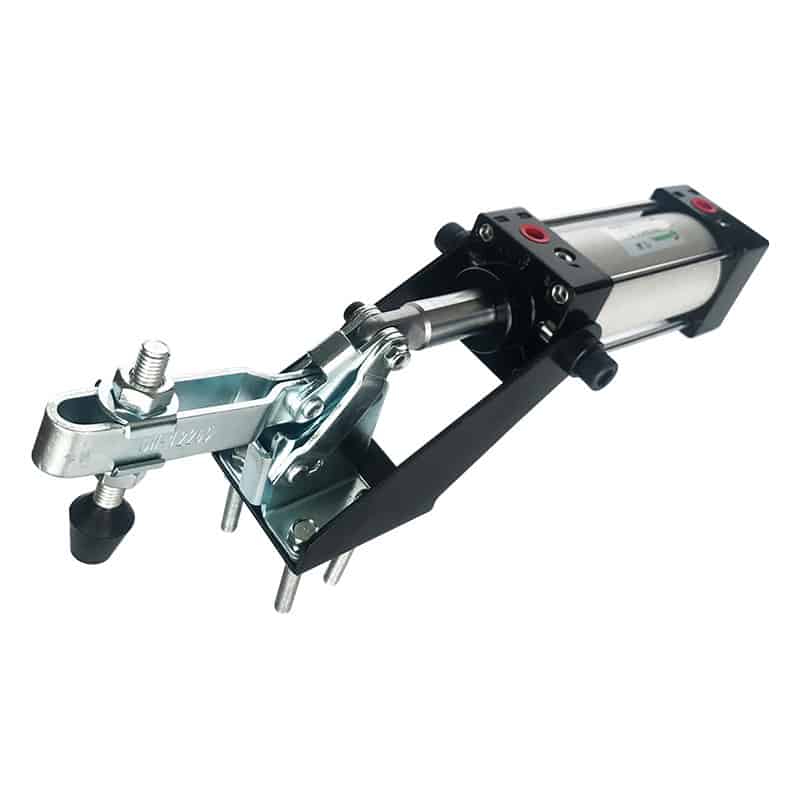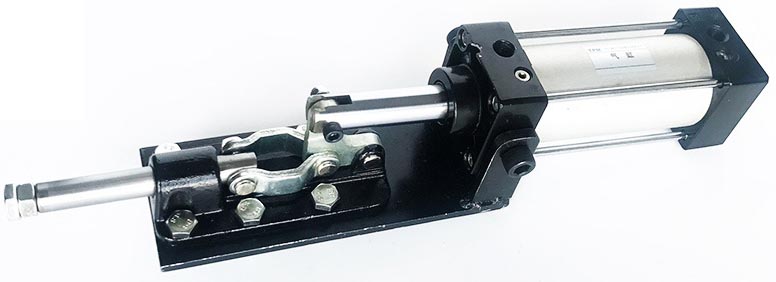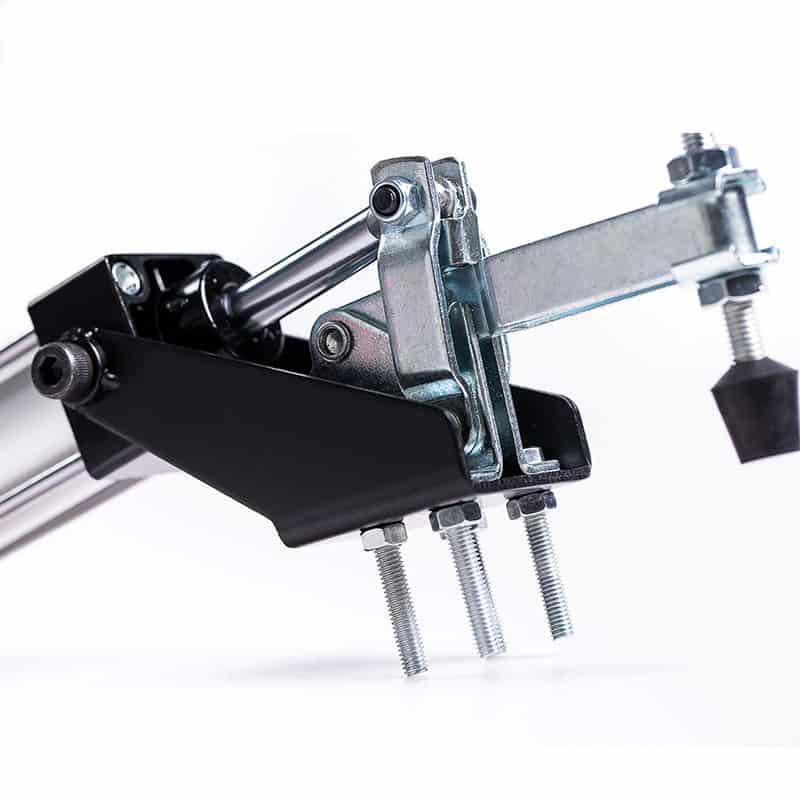Automotive Pneumatic Toggle clamps are widely used in automotive manufacturing and assembly processes. These clamps are designed to provide secure and reliable clamping force, while also offering quick and easy operation. With their ability to provide consistent clamping force and minimize operator fatigue, pneumatic toggle clamps are an essential tool in the automotive industry.
Advantages of using Automotive Pneumatic Toggle Clamps
Automotive pneumatic toggle clamps offer a number of advantages in a manufacturing setting. One of the primary benefits is their ability to provide consistent clamping force, which is important for achieving uniformity in the assembly process. Toggle clamps use a mechanism that locks into place when engaged, providing a secure and stable grip on the material being clamped. Pneumatic toggle clamps are powered by compressed air, which allows for quick and easy clamping and unclamping without the need for manual adjustment. This can save time and reduce the risk of injury to workers.
Another advantage of these toggle clamps is their versatility. They are available in a wide range of sizes and styles, allowing them to be used in a variety of applications. Some types of automotive pneumatic toggle clamps are designed for specific purposes, such as holding down sheet metal during welding or providing a secure grip on parts during machining. Others are more general-purpose and can be used in a variety of applications.
Automotive pneumatic toggle clamps are also designed to be durable and long-lasting. They are typically made from high-quality materials, such as steel or aluminum, and are designed to withstand the rigors of a manufacturing environment. This means that they can provide reliable service for years, reducing the need for frequent replacement and minimizing downtime.

Differences between Automotive Pneumatic Toggle Clamps and other Clamps
Automotive pneumatic toggle clamps differ from other types of clamps used in the automotive assembly in several ways. One key difference is that they use a toggle mechanism to lock into place when engaged, providing a secure and stable grip on the material being clamped. This mechanism is different from the mechanisms used in other types of clamps, such as screw clamps or hydraulic clamps.
Another difference is that automotive pneumatic toggle clamps are powered by compressed air, while other types of clamps may be powered by different means, such as electricity or hydraulics. The use of compressed air allows for quick and easy clamping and unclamping without the need for manual adjustment.
Automotive pneumatic toggle clamps are also available in a wide range of sizes and styles, allowing them to be used in a variety of applications. Some types of clamps are designed for specific purposes, such as holding down sheet metal during welding or providing a secure grip on parts during machining. Others are more general-purpose and can be used in a variety of applications.
Maximum Clamping Force of Automotive Pneumatic Toggle Clamps
The maximum clamping force that can be achieved with an automotive pneumatic toggle clamp depends on a number of factors, including the size and style of the clamp, the pressure of the compressed air used to power the clamp, and the material being clamped.
In general, automotive pneumatic toggle clamps are capable of providing a significant amount of clamping force. The amount of force can range from a few hundred pounds for smaller clamps to several thousand pounds for larger clamps. The clamping force is typically adjustable, allowing the user to set it at the appropriate level for the application.
It is important to note that the maximum clamping force that can be achieved with an automotive pneumatic toggle clamp is not necessarily the same as the force that should be used in a given application. Using too much force can damage the material being clamped or cause other problems. It is important to select the appropriate level of clamping force for each application to ensure a secure and stable grip without causing damage.

Selecting the right size and type of Automotive Pneumatic Toggle Clamp
When selecting the right size and type of automotive pneumatic toggle clamp for a specific application, there are several factors to consider. These include the size and shape of the material being clamped, the required clamping force, and the specific features of the clamp.
The size and shape of the material being clamped will determine the size and style of clamp that is required. If the material is large and flat, a larger clamp with a wider base may be needed to provide a secure grip. If the material is irregularly shaped, a clamp with a more flexible gripping mechanism may be needed to ensure a secure grip.
The required clamping force will also influence the choice of the clamp. If the material being clamped is relatively light and delicate, a clamp with a lower clamping force may be appropriate to avoid damage. On the other hand, if the material is heavy or requires a particularly secure grip, a clamp with a higher clamping force may be necessary.
The specific features of the clamp will also play a role in the selection process. For example, some automotive pneumatic toggle clamps are designed for use in specific applications, such as holding down sheet metal during welding or providing a secure grip on parts during machining. Other clamps may have features such as adjustable clamping force or a quick-release mechanism, which can be useful in certain situations.
It is important to carefully consider all of these factors when selecting the right size and type of automotive pneumatic toggle clamp for a specific application. Choosing the wrong clamp can result in a poor grip or damage to the material being clamped, which can be costly and time-consuming to repair. In the automotive field, pneumatic quick clamps are also frequently used.
Maintenance Required for Automotive Pneumatic Toggle Clamps
To ensure that automotive pneumatic toggle clamps function properly, regular maintenance is required. This includes cleaning the clamps to remove any dirt or debris that may have accumulated, checking the clamping mechanism for signs of wear or damage, and lubricating the moving parts to ensure smooth operation.
Cleaning the clamps is important to prevent dirt and debris from interfering with the clamping mechanism. The clamps should be wiped down regularly with a clean cloth or brush, and any debris should be removed from the moving parts.
Checking the clamping mechanism for signs of wear or damage is also important to ensure that the clamps are functioning properly. Any signs of wear or damage should be addressed immediately to prevent further damage or failure of the clamp.
Lubricating the moving parts of the clamp is important to ensure smooth operation and prevent wear and tear. The specific lubricant used will depend on the type of clamp and the manufacturer’s recommendations. It is important to use the recommended lubricant to avoid damage to the clamp.
Regular maintenance is critical to ensuring that automotive pneumatic toggle clamps function properly and provide a secure grip. Neglecting maintenance can result in damage to the clamps or the material being clamped, which can be costly and time-consuming to repair.

Safety Precautions when using Automotive Pneumatic Toggle Clamps
When using automotive pneumatic toggle clamps, it is important to take appropriate safety precautions to prevent injury to workers and damage to the material being clamped. Some important safety precautions to keep in mind include:
Using the appropriate size and type of clamp for the application
Ensuring that the clamping force is set to the appropriate level for the material being clamped
Keeping hands and other body parts clear of the clamping mechanism when the clamp is engaged
Using appropriate personal protective equipment, such as safety glasses or gloves
Following all manufacturer’s recommendations and safety guidelines
Using the appropriate size and type of clamp for the application is critical to ensuring a secure and stable grip. Using the wrong clamp can result in a poor grip or damage to the material being clamped.
Ensuring that the clamping force is set to the appropriate level for the material being clamped is also important. Using too much force can damage the material while using too little force can result in a poor grip.
Keeping hands and other body parts clear of the clamping mechanism when the clamp is engaged is important to prevent injury. The clamping mechanism can exert a significant amount of force, which can cause injury if body parts are caught in the mechanism.
Using appropriate personal protective equipment, such as safety glasses or gloves, is also important to prevent injury. Some applications may also require additional safety equipment, such as hearing protection or a face shield.
Finally, it is important to follow all manufacturer’s recommendations and safety guidelines when using automotive pneumatic toggle clamps. This includes properly installing and maintaining the clamps, as well as following any recommended safety procedures.
MAILONG’S Conclusion
Automotive pneumatic toggle clamps are a versatile and effective tool for holding down materials in a wide range of automotive applications. Whether used for welding, machining, or assembly, these clamps provide a secure and stable grip that can improve efficiency and quality in automotive production.
When selecting and using automotive pneumatic toggle clamps, it is important to consider a range of factors, including the size and shape of the material being clamped, the required clamping force, and the specific features of the clamp. Regular maintenance and appropriate safety precautions are also critical to ensuring that these clamps function properly and prevent injury to workers.
By carefully considering these factors and taking appropriate precautions, automotive professionals can maximize the efficiency and safety of their operations, while ensuring high-quality and reliable results.
